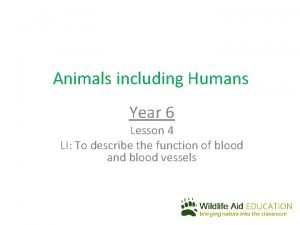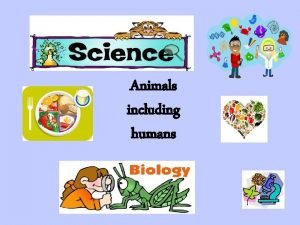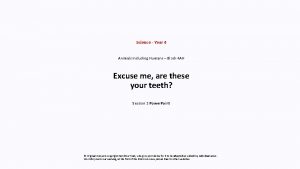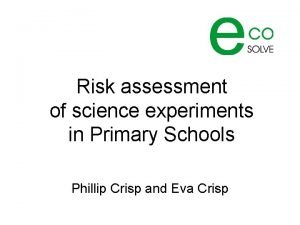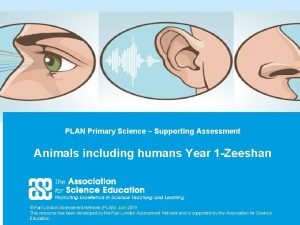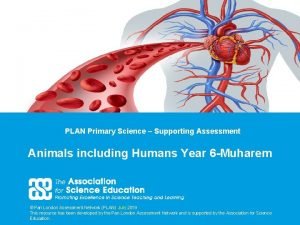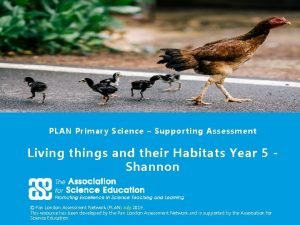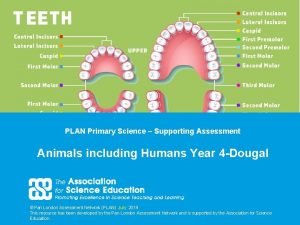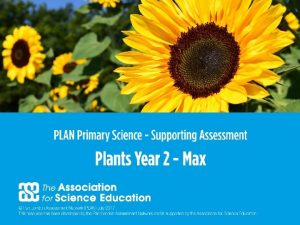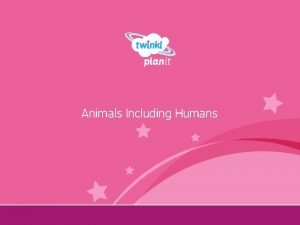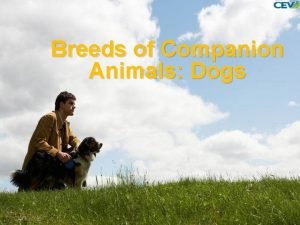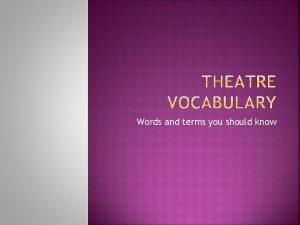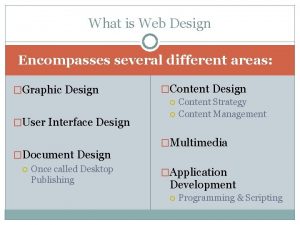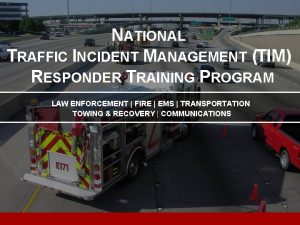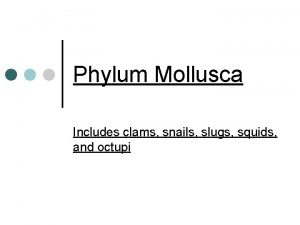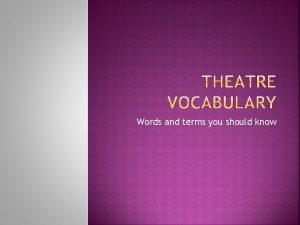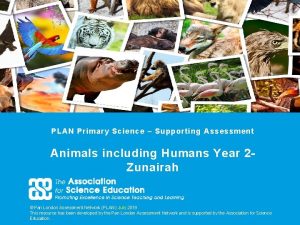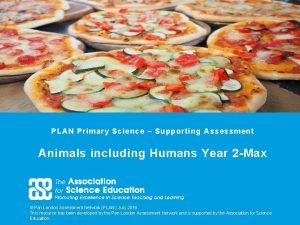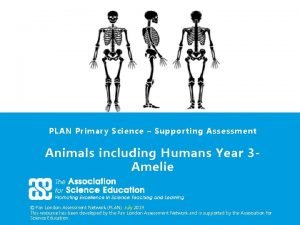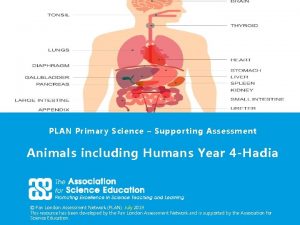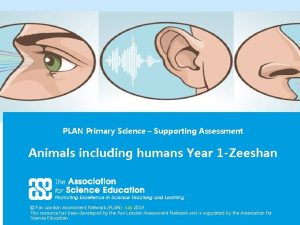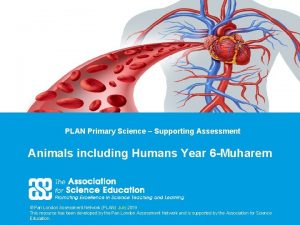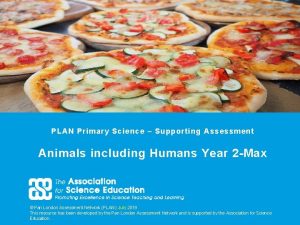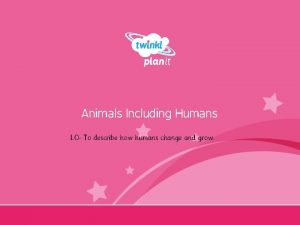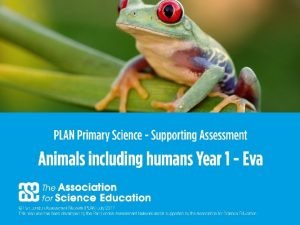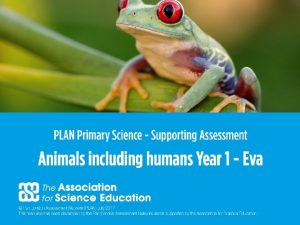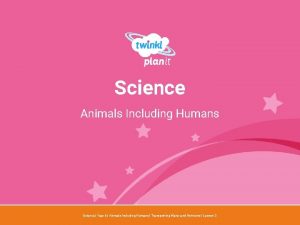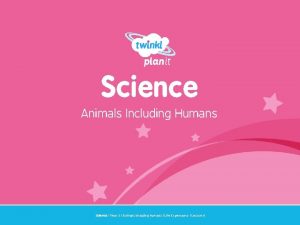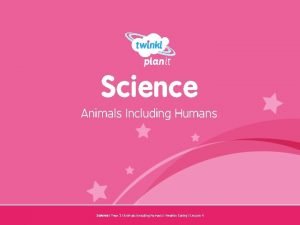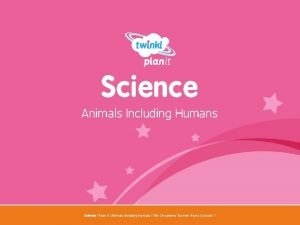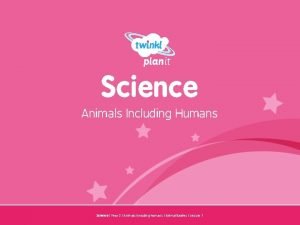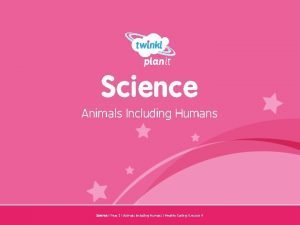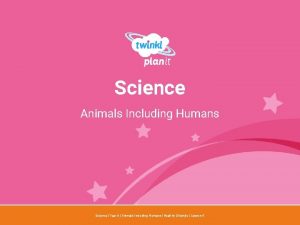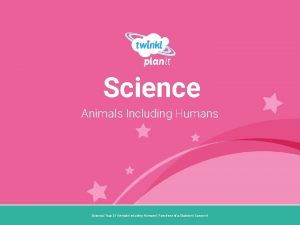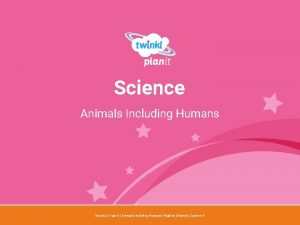PLAN Primary Science Supporting Assessment Animals including Humans


























- Slides: 26

PLAN Primary Science – Supporting Assessment Animals including Humans Year 4 -Dougal © Pan London Assessment Network (PLAN) July 2019 This resource has been developed by the Pan London Assessment Network and is supported by the Association for Science Education. 1

PLAN Primary Science - Supporting Assessment PLAN Primary Science is a set of resources produced to enable teachers to have a clearer understanding of National Curriculum expectations for meeting the standard. Annotated collections of children’s work provide examples of what working at the expected standard for primary science might look like for the knowledge and conceptual understanding statements of the programmes of study (POS). It is not the intention of these resources to specifically exemplify the working scientifically statements. However, aspects of working scientifically have been shown as an integral part of the teaching and learning of the knowledge and concepts. The resources provided have been cross moderated multiple times before publishing so that they can be used with confidence by teachers and subject leaders. Each collection of work shows one example of how a pupil has met National Curriculum statements for a particular area of content but these are not intended to be the definitive way of teaching these statements. 2

Structure of the resources Each resource contains the relevant National Curriculum statements for the unit of work and prior learning, a planning matrix, annotated work and a summary sheet. The matrix provides an interpretation of the key learning of the National Curriculum statements, and suggestions of key vocabulary. In order to be meet the expectations pupils must firstly understand the key concept and then be provided with opportunities to apply that knowledge. This is a key planning tool. Key Learning Secure Possible Evidence Show Overview paragraph describing understanding of a curriculum concept by using scientific Key vocabulary – list of words vocabulary correctly Possible ways to demonstrate key learning, particularly correct usage of vocabulary Apply knowledge in familiar related contexts Possible ways to demonstrate that a pupil has gone beyond recall of facts and can apply the key learning, for example using the vocabulary and basic principles to produce explanations, usually within Working Scientifically contexts. Suggestions of contexts to use. 3

Contents of the materials Please note: The NC statements for each topic area for the relevant year group are stated on the slide. Only the statements in bold on that slide have been exemplified. In these cases the teachers have chosen to split the statements within the topic area to teach at different times. The prior NC statements relevant to the topic area are also stated and use to determine pupils’ knowledge at the start of the unit. Each slide has been annotated with coloured text. Please see key below: Red Commentary to explain how evidence meets/does not meet NC statements Blue Commentary to highlight features of working scientifically Green Pupil Speak Grey Other relevant information eg. vocabulary used 4

Year 1 Statement – Prior learning Prior Learning Year 1 statements Pupils should be taught to: • identify and name a variety of common animals including fish, amphibians, reptiles, birds and mammals (1 -Animals including Humans) • identify and name a variety of common animals that are carnivores, herbivores and omnivores (1 Animals including Humans) • describe and compare the structure of a variety of common animals (fish, amphibians, reptiles, birds and mammals, including pets) (1 -Animals including Humans) 5

Year 2 Statement – Prior learning Prior Learning Year 2 statements Pupils should be taught to: • notice that animals, including humans, have offspring which grow into adults (2 -Animals including Humans) • find out about and describe the basic needs of animals, including humans, for survival (water, food and air) (2 -Animals including Humans) • describe the importance for humans of exercise, eating the right amounts of different types of food, and hygiene (2 -Animals including Humans) 6

Year 3 Statement – Prior learning Prior Learning Year 3 statements Pupils should be taught to: • identify that animals, including humans, need the right types and amount of nutrition, and that they cannot make their own food; they get nutrition from what they eat (3 -Animals including Humans) • identify that humans and some other animals have skeletons and muscles for support, protection and movement (3 -Animals including Humans) 7

Year 4 Statements Year 4 statements Pupils should be taught to: • describe the simple functions of the basic parts of the digestive system in humans • identify the different types of teeth in humans and their simple functions (4 -Animals including Humans) • construct and interpret a variety of food chains, identifying producers, predators and prey (4 -Animals including Humans) 8

Later Statements Pupils do not need to be taught content they will learn in later year groups. They can be challenged by applying the content for their year group in broader contexts. Pupils in Year 5 will be taught to: • describe the changes as humans develop from birth to old age (5 -Animals including Humans) Pupils in Year 6 will be taught to: • identify and name the main parts of the human circulatory system, and explain the functions of the heart, blood vessels and blood (6 -Animals including Humans)

Key learning Possible Evidence Shows understanding of a concept using scientific vocabulary correctly Food enters the body through the mouth. Digestion starts when the teeth start to break the food down. Saliva is added and the tongue rolls the food into a ball. The food is swallowed and passes down the oesophagus to the stomach. Here the food is broken down further by being churned around and other chemicals are added. The food passes into the small intestine. Here nutrients are removed from the food and leave the digestive system to be used elsewhere in the body. The rest of the food then passes into the large intestine. Here the water is removed for use elsewhere in the body. What is left is then stored in the rectum until it leaves the body through the anus when you go to the toilet. Humans have four types of teeth - incisors for cutting, canines for tearing, molars and premolars for grinding (chewing). Living things can be classified as producers, predators and prey according to their place in the food chain. Key vocabulary Digestive system, digestion, mouth, teeth, saliva, oesophagus, stomach, small intestine, nutrients, large intestine, rectum, anus, teeth, incisor, canine, molar, premolars, herbivore, carnivore, omnivore, producer, predator, prey, food chain Can sequence the main parts of the digestive system Can draw the main parts of the digestive system onto a human outline Can describe what happens in each part of the digestive system Can point to the three different types of teeth in their mouth and talk about their shape and what they are used for Can name producers, predators and prey within a habitat Can construct food chains Applying knowledge in familiar related contexts, including a range of enquiries Research the function of the parts of the digestive system Create a model of the digestive system using household objects Explore eating different types of food, to identify which teeth are being used for cutting, tearing and grinding (chewing) Classify animals as herbivores, carnivores or omnivores according to the type of teeth they have in their skulls Use food chains to identify producers, predators and prey within a habitat Use secondary sources to identify animals in a habitat and find out what they eat Can use diagrams or a model to describe the journey of food through the body explaining what happens in each part. Can record the teeth in their mouth (make a dental record) Can explain the role of the different types of teeth Can explain how the teeth in animal skulls show they are carnivores, herbivores or omnivores. Can create food chains based on research SECURE Assessment guidance

Initial assessment activity to hook the children in to the topic – zoom in, zoom out The children were first shown a magnified image and told that it was inside their bodies. The children were asked to describe what they saw and think about what it might be. Dougal’s group suggested it might be the liver, kidney, bladder or guts, but did not know the function of any of these organs. Zoom in The teacher then displayed a zoom out image and with it a labelled diagram of the digestive system. I think it is that squiggly bit as it seems to bend. That is the small intestine. Dougal is able to use the diagram to name the correct part of the digestive system. Zoom out 11

Initial assessment activity - to gauge starting point of new learning in year 4 The teacher displayed the key vocabulary and asked the children to identify which words they had heard before and to give any further information they knew about them. Your mouth makes saliva. It’s spit. The teeth make the food smaller so you can swallow it. Dougal remembered the words small and large intestine, oesophagus and stomach from the previous activity but does not as yet know their function. None of the children were familiar with the words rectum and anus as these were not included in the previous labelled diagram. The children had forgotten their previous learning about nutrition and nutrients. This is prior learning from year 3 but is vital in understanding the role of the digestive system. 12

Initial research – ordering the parts of the digestive system • describe the simple functions of the basic parts of the digestive system in humans Using ipads the children were asked to explore an animation about the digestive system http: //kitses. com/animation/swfs/digestion. swf which also recapped the year 3 learning about the nutrients provided by different types of food. The fish contains protein but the apple didn’t. The digestive system breaks down the food you eat to get the nutrients out. After looking at the animation the children were asked to label the digestive system using labels that were given to them. In hindsight the teacher would have included the word rectum and not pancreas and liver as these are not so essential. Dougal was correctly able to label all the parts of the digestive system. He is beginning to show a general awareness of the function of the digestive system but is not yet secure about the role of the individual parts. 13

Initial research – ordering the parts of the digestive system (contd. ) • describe the simple functions of the basic parts of the digestive system in humans Dougal also wrote some of the things down that he had learnt from playing the animation. Dougal is able to sequence the parts of the digestive system but is not able to give any further 14 information about the function of each part

Generating questions • describe the simple functions of the basic parts of the digestive system in humans The children were asked to think of questions about the digestive system. Dougal’s group came up with five questions. 15

Further research – the function of the parts • describe the simple functions of the basic parts of the digestive system in humans The children were put into four groups and each group was allocated a part of the digestive system. They worked with a partner from their group using i. Pads to learn about the function of their part. They then shared and compared what they had learnt with the rest of their group and decided on the three most important facts which they wrote on large strips of paper to add to the class display. In hindsight the teacher commented she would use different groups next time – It was not possible for the teacher to judge mouth/oesophagus, stomach, small intestine, from this activity Dougal’s current understanding about the function of the parts large intestine and rectum/anus. 16 of the digestive system.

Talk activity – big question • describe the simple functions of the basic parts of the digestive system in humans • identify the different types of teeth in humans and their simple functions The children were asked to discuss the question ‘What would life be like without teeth? ’ using some images to prompt their thinking. We wouldn’t be able to digest properly as we couldn’t break down food. The hidden image was then revealed showing a baby with no teeth. The baby doesn’t need teeth as it drinks milk and doesn’t eat food like us that needs to be broken down. During this activity Dougal has shown that he understands that the role of the teeth is to break food down. This is not currently being linked to getting the nutrients from the food. At this stage there is no evidence to show that Dougal is aware of the different types of teeth and their function. 17

Observing their own teeth • describe the simple functions of the basic parts of the digestive system in humans • identify the different types of teeth in humans and their simple functions The children were given mirrors and asked to look in their mouths and try to count their teeth. The teacher then displayed images of the different types of teeth and asked them to talk about and show their partner the different teeth they had and the number of each. Dougal was able to identify and correctly name the teeth in his mouth. The teacher then gave each child a slice of apple and asked them to eat it thinking about where it went in the mouth and which teeth they were using. To help them remember the names and functions of the different teeth they created class actions for each type of tooth. This video shows the class actions.

Consolidating the learning about teeth • describe the simple functions of the basic parts of the digestive system in humans • identify the different types of teeth in humans and their simple functions The children were asked to complete a sheet showing what they knew about the functions of the different types of teeth. This piece of work shows that Dougal can name the different types of teeth in humans and can give their simple functions. 19

Consolidating the learning about teeth • describe the simple functions of the basic parts of the digestive system in humans • identify the different types of teeth in humans and their simple functions The children were shown two dental records and asked to tell their partner about when they last visited the dentist. . The children were then each given surgical gloves to wear and asked to role play being dentists and patients. Whilst acting as the dentist Dougal mentioned each of the different types of teeth that his patient had and commented on the fact he did not have wisdom teeth as he was not an adult. 20

Consolidating the learning about the digestive system • describe the simple functions of the basic parts of the digestive system in humans • identify the different types of teeth in humans and their simple functions The children were asked to imagine that they were an apple and describe the journey through the digestive system. I was sitting in a nice comfy bowl with my family and some sort of monstrous thing picked me up and popped me in to a hole below his nose which I soon discovered was called a mouth. These white things called teeth crushed me down whilst a red moving thing called a tongue held me in place. I was then made into mush and broken down by a liquid called saliva. I then fell down a long tube called an oesophagus and into a large container called the stomach. The acid in there broke me up into smaller pieces. (continued on next slide)

Consolidating the learning about the digestive system • describe the simple functions of the basic parts of the digestive system in humans • identify the different types of teeth in humans and their simple functions Then I went into a bumpy tube called the small intestine. Don’t tell anyone I was sick. After that I had a little stop but then [went on] through an even bumpier tube called the big intestine. Then the ride was over. I went into a small compartment lots of other waste called the rectum. Then I was pushed out the anus into a white container. In this piece of writing Dougal correctly sequences the basic parts of the digestive system and has included details about some but not all of the parts. He has not talked about the function of the small intestine being the removal of the nutrients or the large intestine’s removal of water. Dougal used the word bank to guide him on what to include and in hindsight the teacher realised that this had not helped him to include the most important pieces of information that he knew. This shows how the teacher will present the vocabulary in the future.

Consolidating the learning about the digestive system by making a video • describe the simple functions of the basic parts of the digestive system in humans • identify the different types of teeth in humans and their simple functions The children were given the names of the parts of the digestive system on cards and asked to sort them into the correct order. In hindsight the teacher would have added the word saliva also They were then given the names of household objects and ask to discuss which object could be used to model the different parts of the digestive system. The plastic bag cards were left on the paper trimmer The masher can be the molars as it crushes the food. The fizzy drink can be the stomach acid. The kitchen towel can be the large intestines as it will absorb the water. Dougal ordered the parts of the digestive system correctly and suggested which objects to use for each part giving reasons linked to the function.

Consolidating the learning about the digestive system by making a video • describe the simple functions of the basic parts of the digestive system in humans • identify the different types of teeth in humans and their simple functions The class then made a video of the model of the digestive system. The teacher then edited the video and the children watched it back and practiced giving a commentary to go with it. Dougal’s commentary shows that he is able to link the model to the parts of the digestive system and can talk about the functions of each part.

Overall summary – secure Dougal can correctly name the types of teeth and their functions. He is able to name and sequence the main parts of the digestive system and can explain the function on each part. He has shown that he is secure with this in his writing and also in the discussion prior to making the video and the commentary he created to go with the modelling video. . 25

Acknowledgements 26
 Animals including humans year 6
Animals including humans year 6 Animals including humans
Animals including humans Animals including humans year 4
Animals including humans year 4 Science risk assessment primary school
Science risk assessment primary school Plan primary science
Plan primary science Plan primary science
Plan primary science Plan primary science
Plan primary science Plan primary science
Plan primary science Plan primary science
Plan primary science My favourite subject is c
My favourite subject is c Https://a-z-animals.com
Https://a-z-animals.com Animals that eat both plants and animals
Animals that eat both plants and animals Parasitic food chain
Parasitic food chain Carnivore
Carnivore Fixation omission emphasis
Fixation omission emphasis Attitude instrument flying
Attitude instrument flying What is the tertiary consumer in the food chain
What is the tertiary consumer in the food chain In a food web what do the arrows represent
In a food web what do the arrows represent Which of the following is not indicative of most beagles?
Which of the following is not indicative of most beagles? Yellow magenta and cyan are the ___
Yellow magenta and cyan are the ___ Printed words including dialogue
Printed words including dialogue It encompasses several different aspects, including
It encompasses several different aspects, including Ice citation method
Ice citation method The mutcd states all workers
The mutcd states all workers Invertebrates including snails slugs and mussels
Invertebrates including snails slugs and mussels Benito doesn't don't know the answer
Benito doesn't don't know the answer Billy wigglestick
Billy wigglestick
